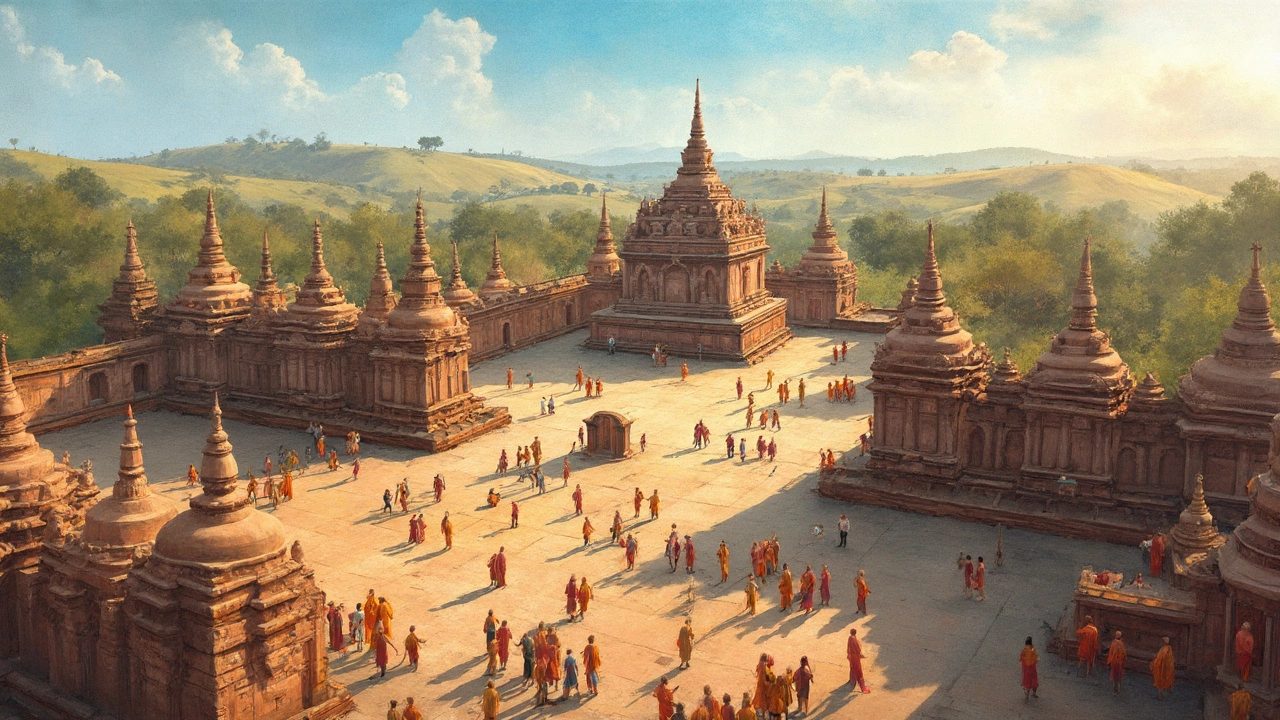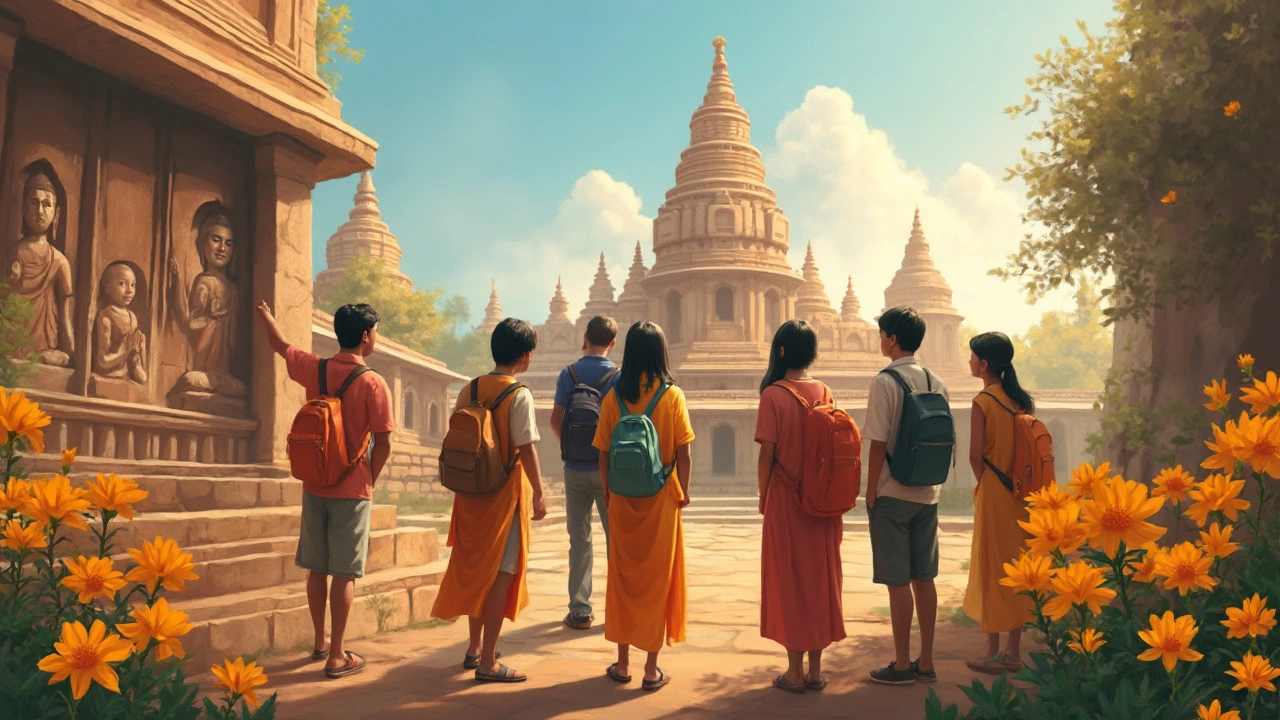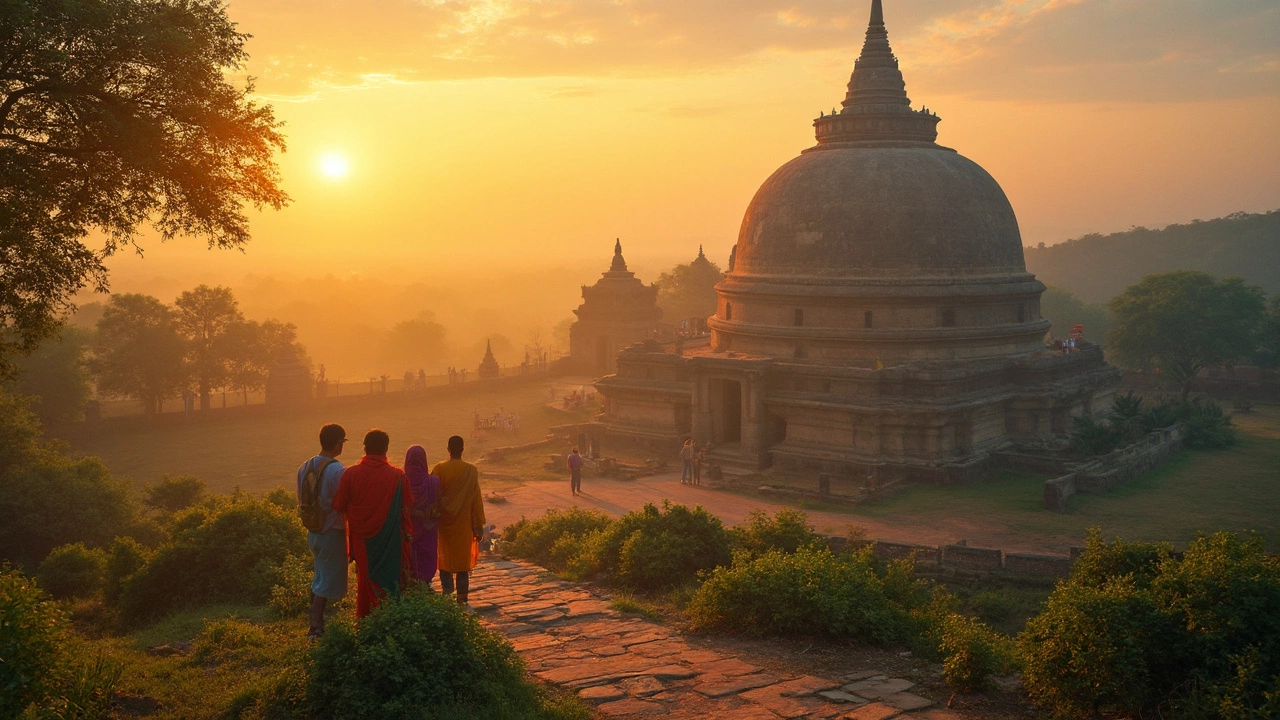Picking India’s oldest landmark isn’t as simple as pointing to the tallest or the most popular monument. If you think it has to be the Taj Mahal or Qutub Minar, think again—those are practically new when you compare them to some of India’s ancient wonders.
The real title goes to the Sanchi Stupa, sitting quietly in Madhya Pradesh since the 3rd century BCE. Built by Emperor Ashoka, way before most countries put up their famous buildings, this mound of stone has seen more history than most cities. You don’t need to be a history buff to be impressed—just imagine how many stories and people this place has witnessed for over two thousand years.
Why does the Sanchi Stupa matter? Well, it’s not just about the age. This structure marks the start of Buddhist architecture in India, giving us a peek into the spiritual and artistic shifts of the time. You’ll find carvings that show how ancient travelers, monks, and artists shaped India’s future. Today, it’s a spot that still draws crowds who want to see where Indian history truly kicked off.
- What Counts as a Landmark?
- The Sanchi Stupa: India’s Oldest Monument
- Surprising Facts About Sanchi
- How to Visit and What to Look For
- Other Ancient Contenders
What Counts as a Landmark?
When people hear “landmark,” they often picture something massive like the Gateway of India or the Taj Mahal. But size isn’t everything—age, cultural impact, and historical importance matter here too. In simple terms, a landmark is any place or structure that stands out, sticks in people’s memories, and tells a part of the country’s story.
Not every old building qualifies. A true landmark survives the ups and downs of time. It gets recognized not just locally, but often by the nation or even the world. These places are shaped by big moments in history—think, a king declaring a new religion or a civilization showing off its best architecture.
In India, the Archaeological Survey of India (ASI) officially lists and protects over 3,600 monuments as landmarks, but being on that list doesn’t guarantee it’s the oldest. The focus for India oldest landmark isn’t only on age, but on how much it shaped Indian culture, religion, or architecture.
So, if you’re wondering what counts, check for three things:
- It should be physically standing—ruins are okay if you can see real remnants.
- It must have a well-documented history that links it to something big in India’s past.
- The place should still grab people’s attention, locally and beyond, for its story or design.
Most places we call landmarks have been declared protected monuments by the government and often pop up in UNESCO World Heritage lists. These recognitions help sort out true landmarks from just old buildings or forgotten ruins.
The Sanchi Stupa: India’s Oldest Monument
The Sanchi Stupa isn’t just old—it’s basically the granddad of Indian monuments, dating back to the 3rd century BCE. Commissioned by Emperor Ashoka of the Maurya Dynasty, the main dome was built to house relics of the Buddha. That’s not a story you find with just any pile of stones.
Even if you’re not big on history, the way the Stupa was made is pretty cool. The core is just solid brick, shaped into a massive dome (or ‘anda,’ if you want the ancient term), and it’s about 16 meters high and 37 meters around. It wasn’t flashy to start—just a plain dome. But over time, locals and rulers added more features. By the first century BCE, those famous stone gateways, or 'toranas', came up. Each gate is covered top to bottom with carvings showing scenes from the Buddha’s life. Instead of statues, the carvings use symbols like the lotus and the wheel—smart way to tell a story without showing faces.
The India oldest landmark saw a lot of action. It was supported by different dynasties, survived invasions, and was almost lost to the jungle. But it’s still there, now a UNESCO World Heritage Site since 1989. That’s a big deal when you think about how many ancient places didn’t survive.
If you ever visit, what stands out is how organized it is. The site isn’t just the main stupa; there are smaller stupas and monasteries all around. It’s not your typical chaotic tourist site.
Here’s some data to give you a better picture:
| Fact | Detail |
|---|---|
| Location | Sanchi, Madhya Pradesh |
| Year built | 3rd century BCE |
| Original purpose | House Buddha’s relics |
| Height | About 16 meters |
| UNESCO World Heritage | Since 1989 |
| Main features | Dome, 4 gateways, detailed carvings |
What makes the Sanchi Stupa unique isn't just age—it’s how much Indian culture you see in one spot. From Buddhist art to stonework, it’s kind of like an outdoor museum, minus the glass displays.

Surprising Facts About Sanchi
The Sanchi Stupa may look simple, but there’s a lot going on beneath that big dome. This isn’t just old—it’s a record holder in several ways.
For starters, the Sanchi Stupa wasn’t built all at once. Ashoka put up the original mound in the 3rd century BCE, but the gateways (toranas) and railing came about 200 years later. Talk about a makeover that lasted generations.
- The carvings here tell stories—literally. Instead of Buddha statues, you’ll find his presence shown by symbols: a footprint, an empty throne, or a wheel (chakra). It’s clever, subtle, and very different from later Buddhist sites.
- Sanchi wasn’t even visited by the Buddha. Its fame comes from being a central spot for Buddhist monks and traders criss-crossing India 2,200 years ago.
- The place totally vanished from people’s minds for centuries. British officer General Taylor rediscovered the site in 1818, buried under dirt and wild plants. Locals didn’t even know what it was.
- All four gateways are covered with carvings that work almost like comics—they show events from Buddha’s life and the Jataka tales. Guides love to play quizmaster, asking visitors to spot familiar scenes.
- UNESCO picked Sanchi as a World Heritage Site back in 1989, calling it the best-preserved group of early Buddhist monuments on earth.
| Fact | Details |
|---|---|
| Original Construction | 3rd century BCE (by Ashoka) |
| Material | Locally sourced sandstone and bricks |
| Rediscovered | 1818 (by General Taylor) |
| UNESCO World Heritage | 1989 |
| Unique Feature | Buddha represented by symbols, not images |
One more thing—thanks to all its layers, restoration efforts have revealed ancient scripts in Brahmi and even names of artisans who worked on the site. So next time you walk those paths, remember: you’re literally stepping through pages of India’s oldest stories.
How to Visit and What to Look For
If you’re thinking about dropping by Sanchi to see India's oldest landmark, planning ahead makes all the difference. Sanchi sits about 50 kilometers from Bhopal, Madhya Pradesh’s capital, which has regular train, road, and even flight connections. A quick train ride or a cab will get you right to the impressive hilltop complex.
The best time to visit is between October and March. Summers can get brutally hot, and walking around the stupa in the afternoon sun isn’t fun for anyone. The site opens by sunrise and closes by sunset, usually between 6:30 AM and 6:30 PM. Entry isn’t expensive—last checked, tickets cost around ₹40 for Indians and ₹600 for foreigners. Kids under 15 typically get in free.
Pack some sunscreen, water, and a cap if you’re visiting during the day. The nearest basic facilities are in the village, so don’t count on fancy restaurants or shops on the hill. Bhopal, on the other hand, has plenty of stay and food options if you want to make a day out of it.
Here’s what not to miss once you’re there:
- The main Great Stupa—look for the famous Ashoka Pillar remnants and walk around the carved stone railings (called toranas). Each gate tells stories from Buddha’s life, carved with crazy detail.
- Other smaller stupas and ruins—Stupas 2 and 3 have their own unique carvings and history.
- The onsite museum—It’s small but packed with relics, coins, and old statues.
- Sunrise or sunset views—The hill gives a wide view of the countryside, and photos turn out amazing in the early or late light.
If you’re short on time, a couple of hours will cover the basics. But if you like checking every corner, plan for half a day—you’ll want to take your time reading the stories in stone.
| Detail | Info |
|---|---|
| Distance from Bhopal | ~50 km |
| Entry Fees | ₹40 (Indians), ₹600 (Foreigners), Kids < 15 Free |
| Best Time to Visit | October to March |
| Opening Hours | 6:30 AM – 6:30 PM |
| Nearest Major City | Bhopal |
Make sure your phone’s charged if you love snapping photos. The Sanchi complex might be ancient, but every carved panel and crumbling stone carries a story you don’t want to miss.

Other Ancient Contenders
If you think the Sanchi Stupa is the only remnant of old India, there’s more on the list fighting for the title of the India oldest landmark. Some of these sites are so old, they make the big city favorites look like new kids on the block.
- Barabar Caves, Bihar: Dating back to the 3rd century BCE, these rock-cut caves are some of the oldest surviving examples of Indian stone architecture. Ashoka’s workers carved these with such precision that you still get an echo inside. They served as shelter for Buddhist monks.
- Bhimbetka Rock Shelters, Madhya Pradesh: These caves offer evidence that humans have hung out here for at least 30,000 years. The walls are plastered with ancient paintings showing scenes from everyday life—think hunters, animals, and handprints. UNESCO gave them World Heritage status because they’re proof of the earliest human settlements in India.
- Ajanta Caves, Maharashtra: Built in two phases from the 2nd century BCE to about 480 CE, these Buddhist caves come packed with detailed paintings and carvings. The Ajanta murals are like Instagram but 2,000 years older, showing daily stories, myths, and even ancient trading routes.
- Udayagiri and Khandagiri Caves, Odisha: Around since the 1st century BCE, these caves were cut out for Jain monks and hold impressive carvings and inscriptions. Pilgrims still visit for a peek at the history carved into the rock faces.
Here’s how a few of the ancient contenders stack up, year-wise:
| Name | Location | Approximate Age (years) | Main Use |
|---|---|---|---|
| Sanchi Stupa | Madhya Pradesh | 2,300+ | Buddhist monument |
| Barabar Caves | Bihar | 2,300+ | Buddhist/Jain retreats |
| Bhimbetka Rock Shelters | Madhya Pradesh | 30,000+ | Habitation, art site |
| Ajanta Caves | Maharashtra | 2,200+ | Buddhist monastery, art gallery |
| Udayagiri-Khandagiri Caves | Odisha | 2,100+ | Jain monastery |
If ancient sites are your thing, these places need to be on your bucket list. Most are in calm, uncrowded areas, making them perfect for anyone who wants to escape tourist hotspots and dig into real old-school India. You’ll see how the earliest Indians lived, worshipped, and got creative with rock and paint instead of Instagram filters.
